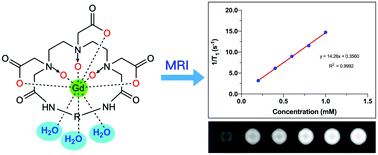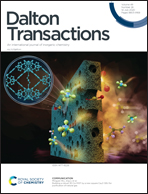Gadolinium complexes of macrocyclic diethylenetriamine-N-oxide pentaacetic acid-bisamide as highly stable MRI contrast agents with high relaxivity†
Abstract
Gadolinium(III) complexes are generally considered efficient magnetic resonance imaging (MRI) contrast agents (CAs) and widely used in clinical applications. High relaxivity and stability are two essential criteria for a Gd(III)-complex to be used as a MRI-CA. One crucial strategy to achieve high relaxivity for small molecular Gd(III)-based MRI contrast agents is to increase the hydration number q. Meanwhile, metal complexes with macrocyclic ligands have been proved to inherit high thermodynamic stability and kinetic inertness. Herein, a series of macrocyclic ligands based on diethylenetriamine-N-oxide pentaacetic acid-bisamide were synthesized. Among them, cyclo-DTPA-NO-C6O2 (3d) was the strongest ligand for Gd(III) as confirmed by experimental results. The hydration number of the Gd-cyclo-DTPA-NO-C6O2 (4d) complex was characterized by luminescence measurements to be 3 and the coordination structure was confirmed with computational simulations. Consequently, the relaxivity of this complex (14.3 mM−1 s−1, 1.5 T, 25 °C) is about triple that of commercial MRI CAs. The conditional stability constant of the Gd(III) complex, pGd, calculated from spectrophotometric titration studies, was comparable to that of one of the most stable commercial MRI-CAs, Gd-DTPA (Magnevist®). Meanwhile, the kinetic inertness of the complex was even higher than that of Gd-DTPA thanks to its macrocyclic coordination structure.



 Please wait while we load your content...
Please wait while we load your content...